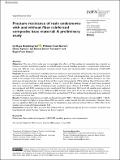Please use this identifier to cite or link to this item:
http://hdl.handle.net/11547/11411| Title: | Fracture resistance of resin endocrowns with and without fiber reinforced composite base material: A preliminary study |
| Authors: | Kaya Büyükbayram, Işıl |
| Keywords: | ENDODONTICALLY TREATED TEETH BIOMECHANICAL CONSIDERATIONS |
| Issue Date: | 2023 |
| Series/Report no.: | 21; |
| Abstract: | Objective:The aim of this study was to investigate the effects of fiber-reinforced composite base material on fracture resistance and fracture pattern of endodontically treated maxillary premolars restored with endocrowns using two different resin nanoceramic computer-aided design and computer-aided manufacturing (CAD/CAM) restorative material. Methods:Forty extracted sound maxillary premolars with an occlusal reduction of 2 mm above the cementoenamel junction (CEJ) was performed following root canal treatment. Mesial interproximal box was prepared for each tooth at the margin of the CEJ and randomly distributed into four groups (n = 10) as follows: Group A, no resin build-up in the pulp chamber; Group B, 2 mm of fiber-reinforced composite (FRC) build-up (EverX Posterior, GC).; Group C, no resin build-up in pulp chamber; Group D, 2 mm of FRC build-up. Groups A and B were prepared with resin nanoceramic (RNC) consisting ceramic nanofillers (Lava Ultimate 3 M ESPE), while Group C and D were prepared with RNC consisting ceramic nanohybrid fillers (Cerasmart GC Corp). All samples were subjected to 1,200,000 chewing cycles (1.6 Hz, 50 N) and 5000 thermal cycles (5 & DEG;C-55 & DEG;C) for artificial aging on a chewing simulator with thermal cycles (CSTC). Samples that survived the CSTC test without being damaged were subjected to a load-to-fracture test. Results:The highest mean fracture strength was found in Group D (936.0 & PLUSMN; 354.7) and lowest in Group A (684.2 & PLUSMN; 466.9). Fracture strength was higher in groups where FRC was used as a base material than plain restorations. However, there were no significant differences between the Lava and Cerasmart groups with and without FRC (p > 0.05). Most of the samples were irreparably fractured under CEJ. Conclusion:Using short FRCs as a resin base material did not significantly improve fracture resistance. Cerasmart and Lava blocks had similar fracture resistance and fracture pattern. |
| URI: | http://hdl.handle.net/11547/11411 |
| ISSN: | 2280-8000 |
| Appears in Collections: | Web Of Science |
Files in This Item:
| File | Description | Size | Format | |
|---|---|---|---|---|
| kaya-buyukbayram-et-al-2023-fracture-resistance-of-resin-endocrowns-with-and-without-fiber-reinforced-composite-base.pdf | 634.3 kB | Adobe PDF |  View/Open |
Items in DSpace are protected by copyright, with all rights reserved, unless otherwise indicated.
